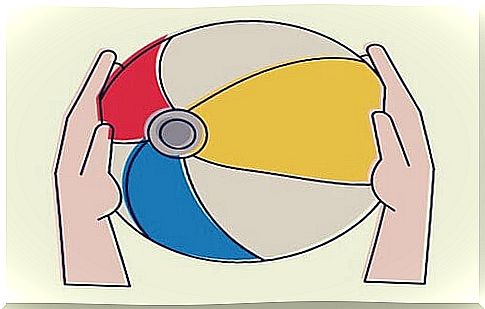The Beach Ball Metaphor To Regulate Emotions

The beach ball metaphor is a very useful resource for regulating negative emotions, especially anxiety. It is a strategy that uses visualization and also requires performance in another dimension: creativity. Each of us deals with our problems in a specific way, and this exercise demonstrates that.
To assess the relevance of this type of tool in psychological practice, it is first necessary to understand what we mean by therapeutic metaphors. It is a series of constructions, reports or rhetorical figures in which the patient must find a relationship between an initial concept and some kind of associated personal reality.
For example, one of the best known therapeutic metaphors is that of quicksand. In this exercise, the goal is to understand that sometimes the more we struggle with our problems, the deeper we sink. The solution, in many cases, is to stop and make contact with what we so much avoid.
In this type of resource, the patient must initiate a series of psychological processes that will be of great help during the therapeutic process. First, it is necessary to understand the metaphor. The patient must identify himself and establish a correspondence between what is explained and what happens to him.
Last, but not least, it is necessary that the person can, by himself, think of some type of strategy that can help him in his life based on the resource that the psychologist has presented to him. The latter will act as a facilitator at all times, but will never solve for the patient the challenge suggested in this exercise.

What is the beach ball metaphor like?
In order for the beach ball metaphor to have an effect and help us, we will resort to visualization. As psychologists McCurry and Hayes, S. C (1992) explain – in their research work Clinical and Experimental Perspectives on Metaphorical Discourse – the creation of mental images favors subsequent memory of metaphors. That way, we can use them whenever we need to.
Let’s see what this exercise consists of.
Visualize in your mind the following situation…
You’re at the beach, it’s a calm and clear day. Light saturates every corner of this perfect setting. However, you don’t feel good. You are anxious, a great number of emotions accumulate, all together, all stirred in an almost painful way: you feel fear, shame, anguish, anger…
- This entire emotional universe is contained in a ball. This object symbolizes what is inside of you, what you feel and what desperately disturbs you. This feeling is so uncomfortable that all you want is for it to go away. And how do you do it? Approaching the beach and sinking the ball into the water.
- View this image clearly: imagine yourself trying to submerge this object. You don’t want anyone to see or notice you. The only thing you want is for it to disappear forever, for the ocean currents to take it away forever. However, every time you dive, the ball goes up again. Furthermore, the more force you exert, the greater the momentum with which it resurfaces, hitting you and causing you to lose balance…
How would you solve the beach ball metaphor?
The next step in the beach ball metaphor requires effort on your part. As we said at the beginning, this feature requires a certain touch of creativity. To resolve it, consider these factors:
- The ball symbolizes your emotions: your anxiety, your fears, your anger, your shame… Dimensions that you have hidden for a long time. However, you already know what effect this has, everything gets worse and slips out of your hands.
- What could you do by following the ball’s metaphorical feature?
Let’s see, below, what is the most common (and useful) answer for this proposal.

The most appropriate strategy
The most appropriate strategy is to stop trying to submerge this object. We must stop wasting energy fighting what is not possible or healthy: trying to submerge the ball and hide emotions is useless. It is not appropriate to accumulate this discomfort any more.
We should pick up the ball and sit calmly on the edge of the beach. The goal? Empty it completely. That way, we’ll feel much better, more relieved. However, first you need to know where the valve is, the button that is holding the air.
It’s the same with emotions. The beach ball metaphor should serve for each of us to find our own specific strategy for making anxiety, fear or shame find a way out. We have to find this “mechanism” that allows us to understand why we feel this way, facilitating access to the path that will free us from this discomfort.
Achieving this is not easy, but at least with this tool we will remember that the ball of our emotions cannot be hidden or submerged. The emotional world must be accepted, understood and released.









